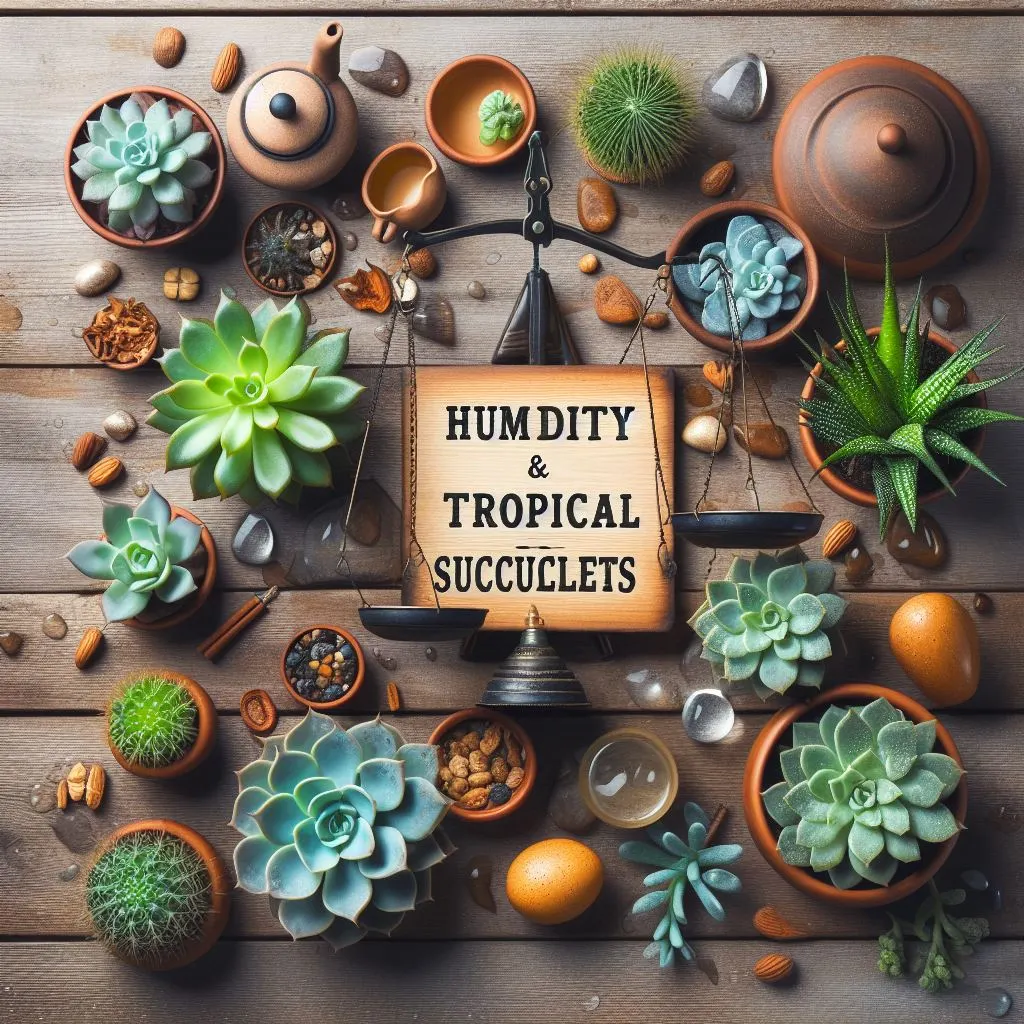Humidity and Tropical Succulents: Finding the Balance
1. What is Humidity?
Humidity is a measure of how much moisture is in the air around us. It’s like when you step outside on a hot day and the air feels sticky or when you notice your breath fogging up a mirror in a steamy bathroom. Humidity tells us how damp or dry the air is, and it plays a big role in the environment around us, including for plants.

When we talk about humidity, we often refer to relative humidity, which is the amount of moisture in the air compared to the maximum amount it can hold at a specific temperature. This is important because it affects how plants like tropical succulents get their water not just from the soil but also from the air through a process called transpiration.
2. Tropical Succulents: Thriving in Warm, Humid Environments
Tropical succulents are a fascinating group of plants known for their ability to store water in their leaves, stems, or roots. Unlike their desert-dwelling relatives, tropical succulents come from regions with higher rainfall and humidity levels, such as tropical forests or coastal areas. This means they have adapted to thrive in environments where moisture is more abundant.
Some popular tropical succulents include aloe vera, which is not only known for its medicinal properties but also for its ability to flourish in warm, humid conditions. Hoya plants, with their waxy and often fragrant flowers, and certain types of cacti that grow in tropical rainforests, are also examples of succulents that enjoy higher humidity levels.
3. The Importance of Balance: Why Humidity Matters for Succulents
Maintaining the right balance of humidity is crucial for the health and well-being of tropical succulents. Here’s why:
- Water Absorption: Succulents use their specialized tissues to store water, but they also absorb moisture from the air through tiny openings called stomata on their leaves. Adequate humidity levels ensure that these stomata can function optimally without the plant losing too much water.
- Transpiration: This is the process by which plants release water vapor through their leaves. It helps them cool down and move nutrients from the soil to different parts of the plant. Balanced humidity supports healthy transpiration rates, keeping the plant hydrated without causing excessive water loss.
- Preventing Stress: Just like humans, plants can get stressed too! High humidity can lead to problems like fungal diseases, while low humidity can cause wilting and slowed growth. Finding the right humidity balance reduces stress on the plant and promotes overall vigor.
4. Tips for Humidity Control: Creating the Ideal Environment
a. Choose the Right Location: Place your tropical succulents in areas with good airflow. This helps prevent stagnant, humid conditions that can promote fungal growth.
b. Humidity Trays: Set your plant pots on trays filled with pebbles and water. As the water evaporates, it creates a humid microenvironment around the plants, mimicking their natural habitat.
c. Mist Sparingly: While misting can increase humidity levels, avoid overdoing it as excess moisture on leaves can invite fungal issues. Aim to mist early in the day so that any excess moisture can evaporate during daylight hours.
d. Monitor with a Hygrometer: Investing in a hygrometer allows you to keep track of humidity levels accurately. Most tropical succulents prefer humidity levels between 50% to 60%. Adjust humidity using humidifiers or dehumidifiers as needed.
e. Grouping Plants: Cluster your tropical succulents together. Plants release moisture through transpiration, and grouping them can create a slightly more humid microclimate for all of them to benefit from.
5. Common Issues and Solutions: Troubleshooting Humidity-Related Problems
a. Fungal Diseases: Excessive humidity coupled with poor airflow can lead to fungal infections like powdery mildew or leaf spot. Improve ventilation, reduce watering frequency, and prune affected parts to manage fungal issues.
b. Root Rot: Overwatering in combination with high humidity can cause roots to rot, leading to wilted and unhealthy plants. Allow the soil to dry out between waterings and ensure pots have proper drainage to prevent waterlogged conditions.
c. Wilting and Leaf Drop: Insufficient humidity can cause succulents to lose moisture faster than they can absorb it, resulting in wilted or dropping leaves. Increase humidity levels using methods mentioned earlier and adjust watering practices accordingly.
6. Conclusion: Happy Succulents, Happy You!
In conclusion, understanding and managing humidity levels are essential for the success of tropical succulents in your care. By creating a balanced environment with adequate airflow and moisture, you can ensure that your plants thrive and display their vibrant beauty.
Observing your plants regularly, monitoring humidity levels, and adjusting care practices as needed will help you overcome common challenges like fungal diseases, root rot, and wilting. Remember, happy succulents not only add greenery to your space but also bring a sense of joy and accomplishment to your gardening endeavors. With these tips and a little love, you can create an oasis of healthy tropical succulents wherever you choose to grow them!